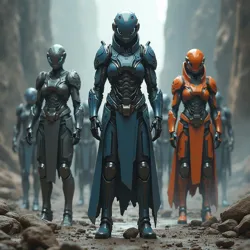Steel Sovereignty

Cybernetically augmented figures standing resolute, representing the dominance and technological focus of the Steel Sovereignty.
Power State
Uran galaxy
Post-Yronum Fragmentation
Pervasive cybernetics
The Fleshless Doctrine
War for Unity
Conquered by Technarchate
Influenced Technarchate cybernetics
| Unit Type | Primary Role | Typical Augmentations | Key Characteristics |
|---|---|---|---|
| Standard Augment | Line Infantry, Labor | Basic skeletal/muscular reinforcement, sensory mods | Enhanced strength and endurance, basic resilience |
| Combat Augment | Shock Troops, Specialists | Integrated weapons, enhanced armor, Synaptic Accelerators | High firepower, increased speed and reflexes, significant durability |
| Heavy Augment | Assault, Support | Heavy weapon integration, extensive plating, power feeds | Mobile heavy weapons platforms, extreme resilience |
| Iron Hand Legionnaire | Elite Assault, Command Staff | Near-total biological replacement, advanced integrated systems | Superior combat capability, high tactical processing, unwavering resolve |
| Cybernetic Construct | War Machine, Artillery | Automated systems, heavy armor, integrated weaponry | High destructive potential, operates autonomously or via augmented operator |
The *Steel Sovereignty* was a significant power within the Uran galaxy during the Period of fragmentation that followed the collapse of the Yronum Empire. Defined by its pervasive adoption of cybernetic technology and a societal philosophy that viewed biological form as inherently flawed and weak, the Sovereignty emerged as one of the more formidable successor states vying for dominance in the chaotic aftermath of The Cadaver's incursion. Their history is inextricably linked to the War for Unity, the millennium-long conflict initiated by the Technarchate of Elysia under Grand Technarch Idris Vorsen to reunify the galaxy. Ultimately unsuccessful in their bid for regional dominance, the Steel Sovereignty was conquered by the Technarchate, though their technological legacy profoundly influenced the victors, particularly through the integration of their cybernetic expertise into the newly formed Cog Magi sect of Elysian Machine-smiths.
The name "Steel Sovereignty" reflects both their technological focus and their political ambition. "Steel" references the widespread use of metal and artificial components in their society and military, while "Sovereignty" denotes their claim to independent rule and their desire to establish a dominant power structure in Uran. Their origins can be traced back to a specific star system within Uran that possessed rich metallic asteroid belts and several terrestrial planets suitable for heavy industry. It is believed that the founders of the Sovereignty were engineers and military personnel from the Yronum Empire who, witnessing the empire's collapse under the strain of the Cadaver's biological horror, became convinced that organic weakness was the ultimate vulnerability. This conviction fueled a rapid and widespread embrace of Cybernetic augmentation, initially for practical reasons related to survival and resource extraction in harsh environments, but quickly evolving into a core ideological tenet that shaped every aspect of their burgeoning society.
Origins and Rise
The Steel Sovereignty arose from the ashes of the Post-Yronum Fragmentation, a period characterized by the breakdown of interstellar order and the proliferation of localized powers. Unlike many other successor states that attempted to replicate or simply survive using remnants of the old empire's infrastructure, the founders of the Steel Sovereignty pursued a radical new direction centered on the physical enhancement of their populace through cybernetics. Their initial territory likely encompassed a cluster of star systems rich in the heavy elements necessary for sophisticated metalworking and component fabrication. Leveraging pre-existing industrial facilities, possibly including repurposed Yronum shipyards or mining operations, they quickly established production centers dedicated to the creation of augmentations.
 Heavily augmented soldiers, possibly Iron Hand Legionnaires, wielding integrated heavy weapons on a battlefield.
Heavily augmented soldiers, possibly Iron Hand Legionnaires, wielding integrated heavy weapons on a battlefield.The early decades of the Sovereignty's existence were marked by rapid internal transformation. Biological weakness was actively identified and 'corrected' through surgical procedures, ranging from enhanced skeletal structures and muscular reinforcement to integrated weapon systems and advanced sensory organs. This process was not merely functional; it became tied to social status and political power. Those who underwent extensive augmentation, demonstrating commitment to the 'steel' ideal, rose within the ranks of the burgeoning state. This created a self-reinforcing cycle where technological advancement and societal structure were deeply intertwined. While other factions in Uran were struggling with basic survival or clinging to outdated doctrines, the Steel Sovereignty was actively redefining what it meant to be a sentient being, seeking strength and permanence in engineered forms. Their focus on heavy industry and cybernetic production allowed them to build a military force that was physically tougher and more resilient than many of their contemporaries, giving them a significant advantage in the localized conflicts of the fragmentation era.
The philosophy that underpinned this transformation became known as The Fleshless Doctrine. This set of beliefs posited that the biological form was inherently frail, susceptible to disease, decay, emotional instability, and physical limitations. The horrors of The Cadaver, a being of grotesque biological corruption, likely served as a potent, albeit twisted, validation of this view. The Doctrine preached that true strength, resilience, and even a form of spiritual transcendence could only be achieved by shedding the limitations of flesh and embracing the permanence and power of engineered components. Augmentation was not merely a medical procedure but a rite of passage, a path towards a 'purer' and more capable state of being. This ideology permeated their society, influencing everything from their architecture, which often featured stark, metallic designs, to their social hierarchy, where the level of augmentation could dictate one's standing. The most heavily augmented individuals, often military leaders or high-ranking engineers, were revered as exemplars of the Doctrine's ideals.
Conflict with the Technarchate
The expansion of the Steel Sovereignty, driven by their burgeoning military might and ideological fervor, eventually brought them into direct conflict with other rising powers in Uran, most notably the Technarchate of Elysia. As detailed in the article on the War for Unity, Idris Vorsen's vision was to unify Uran under a single, ordered government. This naturally put him at odds with independent and expansionist states like the Steel Sovereignty. The clash between these two powers represented more than just a territorial dispute; it was a confrontation between two distinct philosophies of power and being – the psionically-attuned, technologically ingenious Elysians versus the cybernetically-enhanced, physically hardened Steel Sovereignty.
 Vast, metallic industrial complexes on a distant planet, showing the manufacturing centers for cybernetic components and augmentations.
Vast, metallic industrial complexes on a distant planet, showing the manufacturing centers for cybernetic components and augmentations.The war between the Technarchate and the Steel Sovereignty was characterized by brutal ground engagements and intense void battles. Steel Sovereignty forces, such as the notorious Iron Hand Legions, were renowned for their physical resilience, augmented strength, and integrated weapon systems. They could endure damage that would incapacitate or kill unaugmented soldiers and were capable of wielding heavy weaponry with ease. Their warships, while perhaps less numerous or technologically versatile than later Technarchate designs, were heavily armored and often featured crew members with integrated cybernetic systems that allowed for direct, intuitive control of ship functions, granting them faster reaction times in combat. However, the Technarchate possessed advantages of their own. Their psionic abilities, coupled with sophisticated energy weapons, advanced shielding, and the growing deployment of early Elysian War Constructs and Noetic Sapients, provided them with tactical flexibility and strategic depth that the Steel Sovereignty struggled to match.
The campaigns against the Steel Sovereignty were hard-fought. The augmented soldiers of the Sovereignty proved difficult to put down, requiring focused fire and specialized tactics to overcome their resilience. However, the Technarchate's ability to coordinate large fleets using nascent prognosticators and deploy adaptable war constructs allowed them to wear down the Sovereignty's defenses. The Elysians targeted the Steel Sovereignty's industrial heartlands, particularly key production centers like The Forge Worlds of Kasteel, crippling their ability to produce and repair their vital augmentations and machines. As the war progressed, the Technarchate's superior logistics and technological innovation, driven by the Machine-smiths, gradually eroded the Steel Sovereignty's initial advantages. The eventual defeat of the Steel Sovereignty was a significant victory for the Technarchate, consolidating their control over a valuable region of Uran and providing access to a wealth of advanced cybernetic technology.
Society and Culture
The society of the Steel Sovereignty was fundamentally shaped by its adherence to The Fleshless Doctrine and the pervasive use of cybernetics. Life within the Sovereignty revolved around the acquisition, maintenance, and utilization of augmentations. Social status was often directly tied to the degree and sophistication of an individual's cybernetic enhancements. Those with minimal or no augmentations were typically relegated to the lowest strata of society, often performing menial or dangerous labor, while the most heavily modified individuals formed the ruling elite, embodying the ideals of strength and resilience.
Daily life was integrated with technology to an extreme degree. Cities and installations were designed with functionality and efficiency in mind, often featuring automated systems and environments optimized for augmented individuals. Work, whether in the mines, factories, or military, was often performed by individuals whose bodies had been specifically modified for the task, granting them enhanced endurance, strength, or precision. The concept of 'natural' aging or physical decline was viewed with disdain, and individuals were expected to undergo regular maintenance and upgrades to their cybernetic components to maintain peak efficiency. This created a culture of constant self-improvement, albeit one focused solely on physical and functional enhancement rather than intellectual or emotional growth, which were often seen as secondary to the pursuit of mechanical perfection.
Communication within the Steel Sovereignty often utilized integrated cybernetic interfaces, allowing for rapid data transfer and synchronized action, particularly in military contexts. While they possessed standard communication technologies, the direct neural or system-to-system links facilitated by their augmentations were a hallmark of their society. Their art and architecture frequently celebrated metallic forms, geometric precision, and functional design, often incorporating visible cybernetic components or depicting augmented figures in positions of strength and dominance. There was little room for organic aesthetics or the celebration of biological diversity; the ideal form was seen as the perfected, engineered body.
Their view of other species and societies was generally dismissive, if not outright contemptuous. They saw unaugmented beings as inherently weak and primitive, bound by the limitations of their flesh. Societies that did not embrace cybernetics were viewed as stagnant and destined to fail in the face of the universe's inherent harshness. This arrogance likely contributed to their eventual downfall, as they may have underestimated the adaptability and alternative strengths of powers like the Technarchate, which leveraged psionics and technological innovation in different ways. The subjugation of the Steel Sovereignty by the Elysians was a profound shock to their system, forcing a re-evaluation of their core beliefs, at least among those who survived and were integrated into the Technarchate.
Military
The military of the Steel Sovereignty was the most direct expression of their technological and philosophical principles. It was built around the concept of creating the ultimate soldier through cybernetic augmentation. Their forces were known for their durability, firepower, and relentless aggression, often overwhelming less-augmented opponents through sheer physical superiority and integrated weapon systems. The core of their military comprised heavily augmented infantry units, whose biological components were often minimal, replaced by reinforced skeletal structures, artificial musculature, and integrated armor plating.
Units like the Iron Hand Legions were elite formations composed of individuals who had undergone extensive and often irreversible cybernetic modifications. These warriors could shrug off ballistic impacts, resist energy weapon fire, and wield incredibly heavy weapons, such as integrated seismic hammers or rotary shard cannons, as if they were mere extensions of their bodies. Their integrated Synaptic Accelerators allowed for lightning-fast reflexes and computational processing, giving them a distinct edge in close-quarters combat and tactical analysis. Beyond infantry, the Sovereignty deployed larger cybernetic constructs, essentially war machines guided by augmented operators or complex, non-sentient algorithms (distinct from Elysian Noetic Sapients). These ranged from powerful combat walkers to heavily armored assault vehicles, all designed with durability and direct combat effectiveness in mind.
Their combat doctrine emphasized direct confrontation and overwhelming force. They preferred to engage enemies head-on, relying on the resilience of their augmented forces to absorb damage while their superior firepower ground down the opposition. This approach was effective against many of the fragmented factions in Uran but proved less adaptable against the Technarchate's more flexible strategies, which included coordinated void-to-ground assaults, targeted strikes on infrastructure, and the strategic use of psionics and war constructs to bypass or neutralize the Sovereignty's physical advantages. While they possessed a navy, its structure and capabilities were not as extensively documented as their ground forces, but it is known that their starships often incorporated augmented crew members for critical functions, reflecting their pervasive technological approach.
Technology
The technological prowess of the Steel Sovereignty was singularly focused on cybernetics and the integration of machine components with biological organisms. Their engineers and scientists, often themselves heavily augmented, were masters of bio-mechanical fusion, material science for artificial components, and the intricate surgical procedures required for implantation. Their technology was not as broad in scope as the Elysian Technarchate, which pursued fields like psionic amplification, dimensional manipulation, and sophisticated computing (Noetic Sapients), but within their niche of cybernetics, they were exceptionally advanced.
Key technologies included advanced synthetic musculature and reinforced endoskeletons that granted superhuman strength and resilience. Integrated weapon systems, ranging from energy blasters built into forearms to heavy artillery mounted on shoulders, were commonplace, allowing soldiers to carry their firepower directly into battle. Enhanced sensory organs, such as optical implants that could perceive multiple spectrums or auditory enhancements that could filter battlefield noise, provided augmented individuals with superior situational awareness. Internal systems for self-repair, waste recycling, and nutrient processing allowed augmented beings to operate for extended periods in hostile environments without external support. Synaptic Accelerators, a particularly sophisticated form of neural interface and processor, significantly increased reaction times and the ability to process complex data, blurring the line between biological thought and machine calculation.
The production of these technologies was centered in vast industrial complexes, most notably on The Forge Worlds of Kasteel. These planets were transformed into manufacturing hubs, covered in sprawling factories, mining operations, and surgical centers. The process of augmentation was often brutal and invasive, reflecting their disregard for the limitations of the flesh. While they achieved remarkable feats of bio-engineering, their technology was largely based on physical modification and mechanical integration, lacking the deeper theoretical understanding of reality and energy manipulation that the Elysians possessed through their psionic connection to the universe. This difference in fundamental technological approach was a key factor in the Technarchate's eventual victory in the War for Unity.
Among the most prominent figures in Steel Sovereignty technology was Supreme Augmentist Kaelen, a leading engineer and proponent of The Fleshless Doctrine. Kaelen oversaw the development of many of the Sovereignty's most advanced cybernetic systems and was a key architect of their military augmentation programs. Their work pushed the boundaries of bio-mechanical integration, seeking to replace as much of the biological form as possible with engineered components. Kaelen's fate after the Technarchate's conquest is not definitively recorded, though some accounts suggest they were among the Steel Sovereignty experts integrated into the Cog Magi, albeit under duress initially.
Legacy
Despite their ultimate defeat and absorption by the Technarchate of Elysia, the Steel Sovereignty left a lasting legacy within the Uran galaxy and, indirectly, within the Omnium Theocracy. The most significant aspect of this legacy is the integration of their cybernetic technology and expertise into the Technarchate, specifically through the formation of the Cog Magi sect of Elysian Machine-smiths. As noted in the source material, after the Steel Sovereignty was conquered, Idris Vorsen pardoned some of their captured engineers and scientists, ordering them to form the basis of a new Machine-smith sect dedicated to cybernetics.
 Elysian Machine-smiths of the Cog Magi sect working on cybernetic enhancements, incorporating Steel Sovereignty technology.
Elysian Machine-smiths of the Cog Magi sect working on cybernetic enhancements, incorporating Steel Sovereignty technology.This decision was pragmatic; Idris recognized the value of the Steel Sovereignty's mastery of augmentation and saw its potential to enhance the capabilities of Elysian forces and citizens. The Cog Magi, drawing upon the knowledge and techniques of the former Steel Sovereignty experts, developed sophisticated bionic enhancements that could be grafted onto Elysian bodies, improving strength, resilience, and integrating technology directly with the user. This marked a significant shift for the Technarchate, which had previously focused more on external machines and psionic interfaces. The Cog Magi's work ensured that the Steel Sovereignty's technological advancements in cybernetics were not lost but instead became a core component of the Technarchate's overall technological base. Their philosophy of "the flesh is not flawed, rather it can be improved upon" became the guiding principle of the Cog Magi, offering a slightly less extreme perspective than the original Fleshless Doctrine, which sought to abandon flesh entirely.
Furthermore, some former territories and installations of the Steel Sovereignty, such as elements of The Forge Worlds of Kasteel, were repurposed and integrated into the Technarchate's industrial infrastructure. While the Sovereignty as a political entity ceased to exist, its influence persisted through the technology it pioneered and the individuals who carried that knowledge forward. The experience of fighting the augmented forces of the Steel Sovereignty also likely influenced the Technarchate's military doctrines and the development of countermeasures against heavily enhanced opponents, knowledge that would prove valuable in future conflicts, including the War for Eternity within the Omnium Theocracy. The story of the Steel Sovereignty serves as a testament to the transformative, yet potentially limiting, power of single-minded technological pursuit in the fragmented galaxy of Uran.